For Blake – Overnight Jupiter Shines with Saturn, the Moon Moves into Morning, and King Cepheus Rules the North!
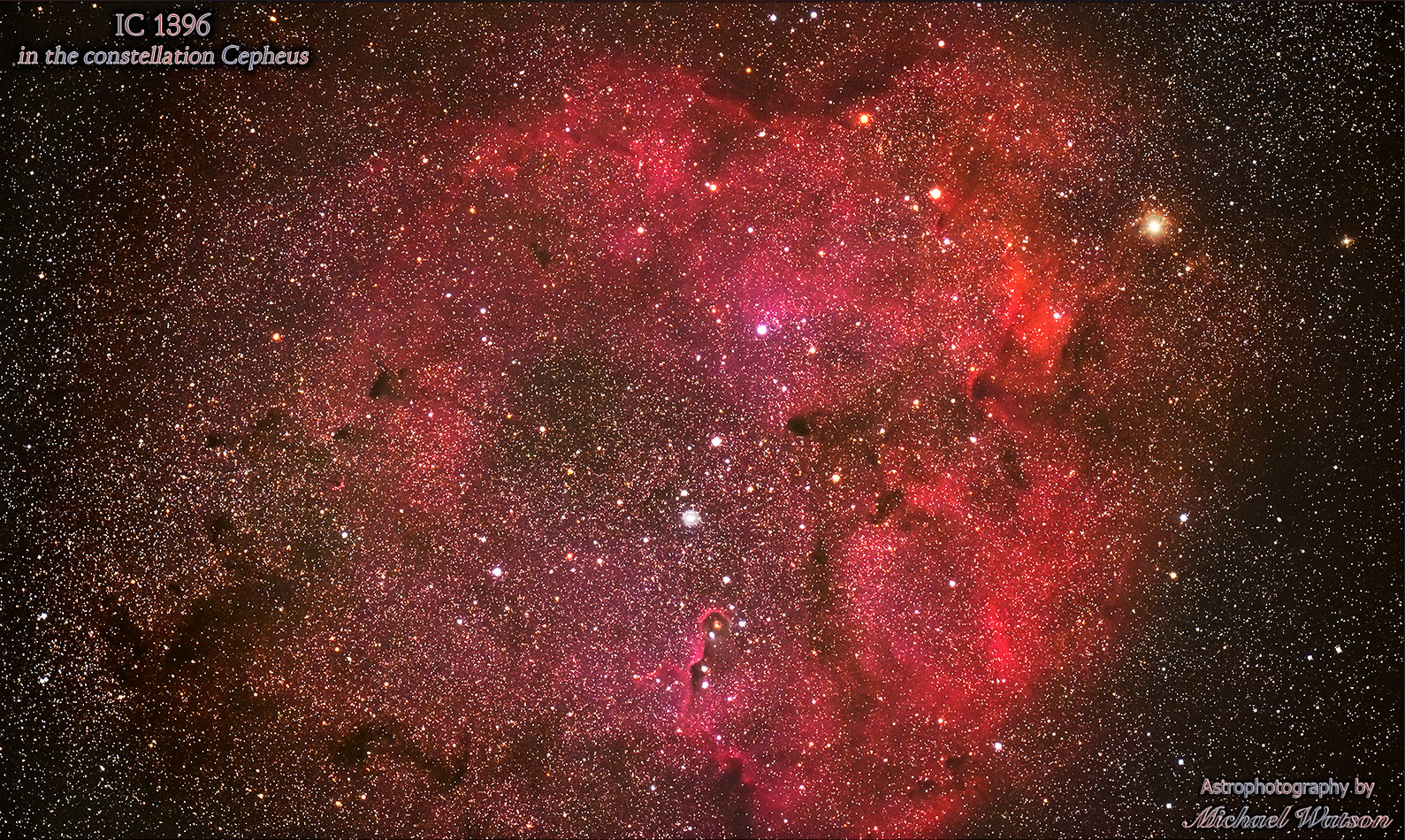
In this image captured by Michael Watson on September 24, 2017, the Elephant’s Trunk Nebula in Cepheus protrudes upwards into the red hydrogen emission region, from below centre. Herschel’s Garnet Star, also known as Mu Cephei, is glowing brightly orange-red at upper right. This image spans about five degrees of sky, from left to right. Michael’s galleries are at https://www.flickr.com/photos/97587627@N06/
Hello, September Stargazers!
Here are your Astronomy Skylights for the week of September 3rd, 2023 by Chris Vaughan. Feel free to pass this along to your friends and send me your comments, questions, and suggested topics. You can also follow me on Twitter as @astrogeoguy! Unless otherwise noted, all times are expressed in Eastern Time. To subscribe to these emails please click this MailChimp link.
If you’d like me to bring my Digital Starlab portable inflatable planetarium to your school or other daytime or evening event, or deliver a session online, contact me through AstroGeo.ca, and we’ll tour the Universe, or the Earth’s interior, together! My terrific book with John A. Read entitled 110 Things to See With a Telescope is a guide to viewing the deep sky objects in the Messier List – for both beginners and seasoned astronomers. DM me to order a signed copy!
The moon will wane in phase and shine mainly during the wee hours and morning daylight this week, leaving evening skies worldwide nice and dark for the Summer Milky Way and the sights of Polar King Cepheus. Bright Jupiter and Saturn, plus their far fainter companions Neptune and Uranus, will shine all night long. Venus will shine at dawn. Read on for your Skylights!
A New Star
Those of us in the Canadian astronomy scene are mourning the loss of a brilliant, dear friend, Blake Nancarrow, gone far too soon. His battle with prostate cancer came to an end as the stars began to appear on Friday evening.
Blake was the da Vinci of amateur astronomy – an expert on almost every topic, especially double stars, an inventor and maker, presenter, author of a column on astronomy-related apps for RASC’s Journal, and a contributor to their Observers Handbook. He always had time to help someone getting started with telescopes, cameras, software, or what to look at. We’d spend hours chatting on the phone – geeking out about some new feature in Stellarium, which I use to produce Skylights, the robotic Burke-Gaffney Observatory, or the RASC observing programs, which he was RASC’s lead on. I’ve shared some of Blake’s work here in the past, linking to his extensive blog at http://blog.lumpydarkness.com/.
The next time you see the stars twinkling overhead, send Blake some good wishes. We never got to take that road trip for a spring Messier Marathon, but I’m sure he’s out there visiting Albireo and the rest of his favorite stellar duos. We miss him already. Have a great adventure, dude.
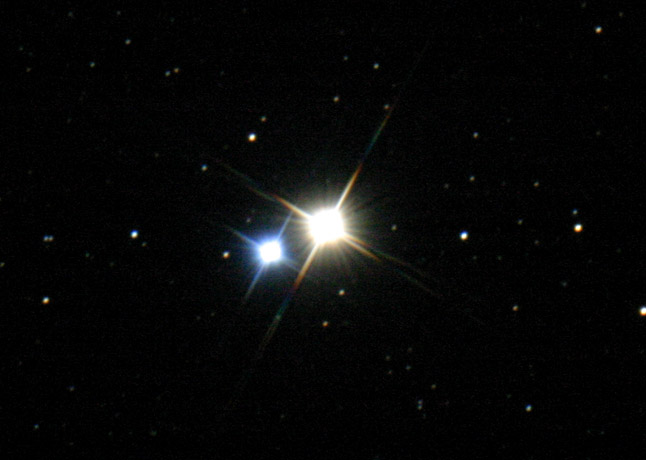
The Moon
This will be a transitional week for the moon. As its orbit drives it towards the sun, it will transition out of the late night sky and move into the pre-dawn sky worldwide – bringing the final block of dark moonless nights for summer in the Northern Hemisphere.
The bright, waning gibbous moon will rise, surrounded by the stars of Aries (the Ram), at about 9:45 pm local time tonight (Sunday). About half an hour later the brilliant planet Jupiter will rise to join it. The pair will cross the sky through the night. Hour by hour, the moon’s easterly orbital motion will carry it closer to Jupiter. Meanwhile, the diurnal rotation of the sky will lift the planet higher than the moon by dawn, when they’ll shine high in the southwestern sky.
If you spot the moon’s pale orb in the daytime sky on Monday morning, use binoculars to seek out Jupiter positioned to the moon’s upper left. They’ll be on the opposite edges of your binoculars’ field of view.
On Monday night, the moon will hop east to shine on Jupiter’s left (or celestial northeast), still within the Ram’s borders. The bright little Pleiades star cluster will be positioned nearly a fist’s diameter to the bright moon’s lower left. The planet Uranus will be located just a few finger widths below the moon. That’s cozy enough for them to share the view in binoculars. Uranus’ bluish magnitude 5.7 speck can be seen in binoculars and any backyard telescope. The moon’s easterly orbital motion will shift it to the planet’s upper left if you are viewing them later at night or in a more westerly time zone.
The moon will spend Tuesday through Thursday travelling through Taurus (the Bull). On Tuesday night, after the moon rises around 10:45 pm, the Pleiades will sparkle less than a binoculars’ field above it. In Greek mythology, those “Seven Sisters” stars are the daughters of Atlas and Pleione. Look for those characters as a pair of stars offset a small distance to the lower left (or celestial west) from the rest of the cluster – proud parents watching over their children.
Night owls can also see the Hyades cluster below the moon. The Hyades is a large, triangular group of stars that form the face of the Bull. The bright, reddish star Aldebaran shining at the lower (southeastern) corner of it forms the bull’s eye. The Pleiades and the Hyades are open clusters, composed of stars that formed together as genuine celestial siblings. The two groups are half-sisters in mythology.
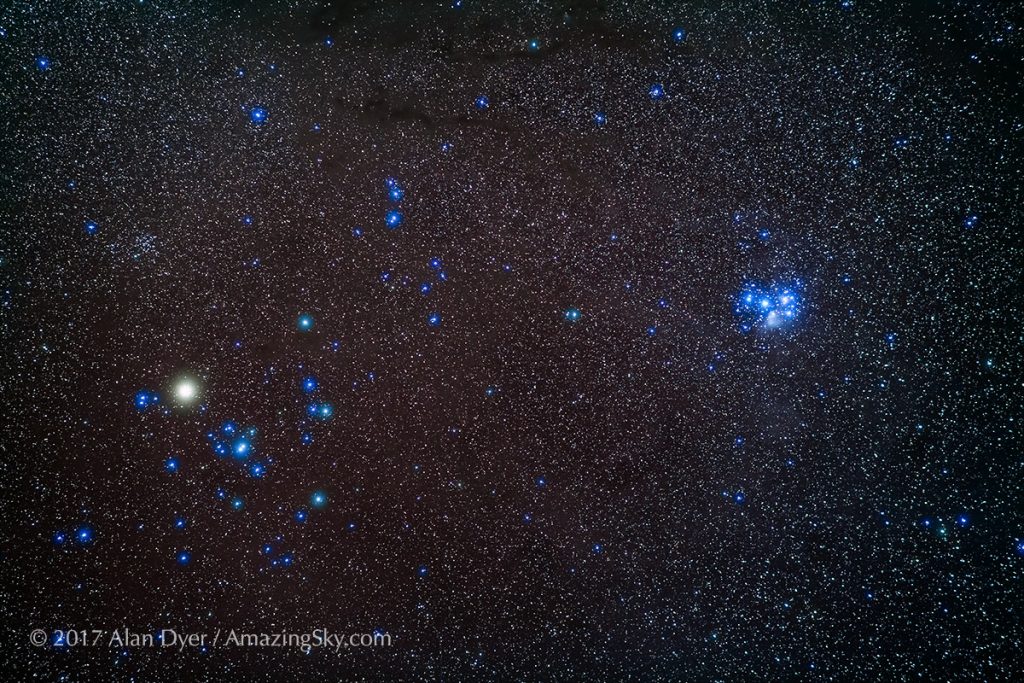
The moon will complete three quarters of its orbit around Earth, measured from the previous new moon, on Wednesday at 6:21 pm EDT and 3:21 pm PDT or 22:21 Greenwich Mean Time. At the third (or last) quarter phase the moon appears half-illuminated, on its western, sunward side. It will rise around midnight local time, and then remain visible until it sets in the western daytime sky in early afternoon.
The waning crescent moon will spend the remainder of this week among the stars of Gemini (the Twins) – but you’ll only see that if you are outside between midnight and dawn. On Friday morning another big, though fainter open cluster called the Shoe-Buckle (or Messier 35) will be located binoculars-close to the moon’s lower right. The higher twin’s bright toe stars will shine just below the cluster, hence its name.
When the waning crescent moon rises over the northeastern rooftops during the wee hours of next Sunday morning, it will make a pretty sight aligned below Gemini’s brightest stars Pollux and Castor. The moon will be close enough to the lower star, warm-tinted Pollux, for them to share the field of view of binoculars. For observers viewing them in westerly time zones, the moon will be a little farther from Pollux. After brilliant Venus rises around 4:30 am, it will shine below the moon.
The Planets
Our time for enjoying the gas giant planets is here! Jupiter and Saturn will be available for our evening viewing pleasure until mid-winter!
As the sky darkens after sunset, the creamy-yellow dot of Saturn will be shining low above the southeastern horizon. Recently past opposition, the ringed planet will shine all night long as it crosses the sky. You’ll get the clearest views of Saturn in a telescope after 9 pm local time, when it will be higher in the sky. The faint stars of Aquarius (the Water-Bearer) and Capricornus (the Sea-Goat) will be shining to the left and right of Saturn, respectively. The bright trio of the Summer Triangle asterism stars will sparkle well above, and the Great Square of Pegasus stars will be off to the planet’s upper left. The very bright star Fomalhaut (or Alpha Piscis Austrini, the Southern Fish) will shine two fist diameters below Saturn all year.
Saturn’s beautiful rings are visible in any size of telescope. If your optics are of good quality and the air is steady, try to see the Cassini Division, a narrow gap curving between the outer and inner rings, and a faint belt of dark clouds that encircle the planet’s globe. Remember to take long, lingering looks through the eyepiece – so that you can catch moments of perfect atmospheric clarity. Good binoculars can hint at Saturn’s rings, too.
From here on Earth, Saturn’s axial tilt of 26.7° lets us see the top of its ring plane, and allows its brighter moons to array themselves above, below, and alongside the planet. Saturn’s largest and brightest moon Titan never wanders more than five times the width of Saturn’s rings from the planet. The much fainter moon named Iapetus can stray up to twelve times the ring width during its 80-day orbit of Saturn. The next brightest moons Rhea, Dione, Tethys, Enceladus, and Mimas all stay within one ring-width of Saturn.
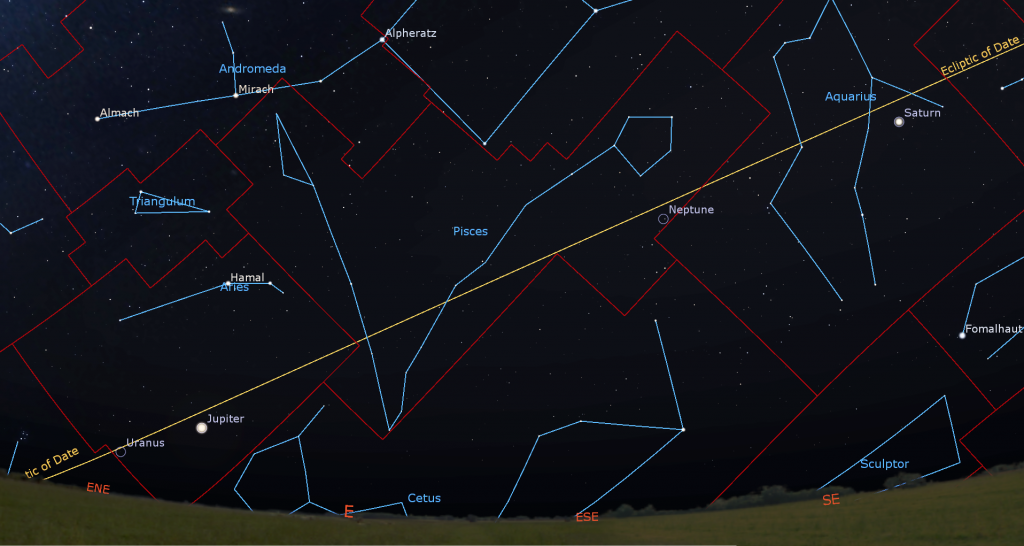
During this week, Titan will migrate counter-clockwise around Saturn, moving from the planet’s upper right (celestial west) tonight (Sunday) to Saturn’s lower left (celestial east) next Sunday night. (Remember that your telescope will probably flip the view around.) How many of the moons can you see in your telescope? You may be surprised at how many you can see if you look closely. This summer the blue ice giant planet Neptune, currently 840 times fainter than Saturn, will be lurking about two fist diameters to Saturn’s lower left, or 23° to its celestial northeast.
Brilliant, white Jupiter, which currently shines about 17 times brighter than Saturn, will clear the eastern treetops shortly after 11 pm local time. On Monday, Jupiter will commence a retrograde motion period that will last until early January. This year Hamal and Sheratan, the brightest stars of Aries (the Ram), will shine a generous fist’s diameter above the giant planet. Jupiter will spend the rest of the night following Saturn across the sky. It should catch your eye while it gleams high in the southwestern sky before sunrise. The waning gibbous moon will hop past Jupiter on Sunday and Monday night.
Binoculars will show you Jupiter’s four Galilean moons in a line beside the planet. Named Io, Europa, Ganymede, and Callisto in order of their orbital distance from Jupiter, those moons complete orbits of the planet every 1.7, 3.6, 7.2, and 16.7 days, respectively. If you see fewer than four moons, then one or more of them is crossing in front of or behind Jupiter, or hiding in Jupiter’s dark shadow – or two of the moons are very close together or occulting one another. All four of them will huddle to the west of Jupiter tonight (Sunday) and Wednesday night.
Jupiter will climb high enough for good telescope views after about midnight local time. It’ll look even better from then until dawn. Even a small, but decent quality telescope can show you Jupiter’s dark belts and light zones, which are aligned parallel to its equator. With a better grade of optics, Jupiter’s Great Red Spot, a cyclonic storm that has raged for hundreds of years, becomes visible for several hours when it crosses the planet every 2nd or 3rd night. For observers in the Americas, that GRS will cross Jupiter’s disk late tonight, Wednesday, and Friday. It’ll appear early on Wednesday and Saturday morning, and before dawn on Friday and next Sunday morning. If you have any coloured filters or nebula filters for your telescope, try enhancing the spot with them.
From time to time, the small, round, black shadows cast by Jupiter’s Galilean moons become visible in amateur telescopes when they cross (or transit) the planet’s disk. On Monday morning, September 4, Io’s small shadow will cross Jupiter’s equatorial region from 1:22 to 3:24 am EDT (or 05:22 to 07:24 GMT). On Thursday morning, September 7, Ganymede’s big shadow will cross Jupiter’s southern polar region from 2 am to 3:35 am EDT (or 06:00 to 07:35 GMT). On Friday morning, September 8, Europa’s small shadow will cross Jupiter’s southern hemisphere from 12:35 am to 2:50 am EDT (or 04:35 to 06:50 GMT). (These times may vary by a few minutes.)
The blue-green ice giant planet Uranus will be following Jupiter across the sky this year. This week Uranus will be located a generous palm’s width to Jupiter’s lower left (or 7.5° to the celestial east). The bright little Pleiades star cluster will be located a similar distance to Uranus’ left. Magnitude 5.8 Uranus is visible in binoculars and small telescopes if you know where to look. I’ll get more specific in the coming weeks when it will climb higher.
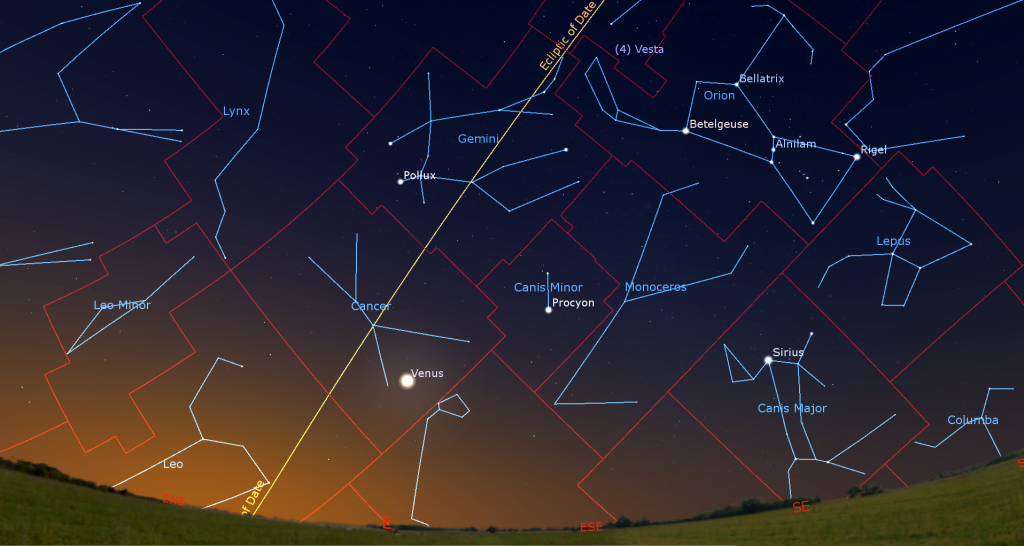
Brilliant Venus will be shining in the eastern pre-dawn sky from now until January, climbing farther from the sun with each passing day. This week Venus will rise among the stars of Cancer (the Crab) at about 4 am local time. Early risers can enjoy the winter constellations and stars nearby. Viewed in a telescope this week, our sister planet will exhibit a large disk and a very slim waxing crescent phase. Turn all optics away from the eastern horizon before the sun rises.
Mars is too close to the sun to be seen easily after sunset nowadays, and Mercury will enter the eastern pre-dawn sky next week.
Cepheus the King of the Pole
For observers living at mid-northern latitudes around the world, the constellations that circle the north celestial pole stay above the horizon at all times – day and night. But that doesn’t mean they are always visible. The circumpolar Big Dipper is part of the large constellation Ursa Major (the Big Bear). During evening in autumn every year, Ursa Major sits so low over the northwestern horizon that the stars of the famous dipper are often hidden behind buildings or trees. Six months later, that constellation is nearly overhead during evening – the best position for exploring its deep sky treats.
From September to December, the circumpolar constellation of Cepheus (the King) sits nice and high in the northern sky during evening, perfectly positioned for viewing – and it contains some fascinating sights because it’s located close to the Milky Way. Let’s explore the king of the North Pole!

In Greek mythology, Cepheus was the king of ancient Ethiopia. He was married to Queen Cassiopeia. Their daughter Andromeda was the princess who was rescued by the hero Perseus, who rode the winged horse Pegasus. Each of those characters is represented by a constellation in the northeastern sky during autumn. I’ll relate their tale in a future Skylights. In Arabic tradition, Cepheus was named Al-Multaheb. In ancient China, the stars of Cepheus were divided amongst the Black Tortoise of the North (北方玄武, Běi Fāng Xuán Wǔ) and the Three Enclosures (三垣, Sān Yuán), part of the Heavenly Purple Palace that occupies the region around Polaris. Other ancient cultures incorporated Cepheus’ brightest star, Alderamin, into their own star pictures.
For those of us who have been using the three bright stars of the Summer Triangle to navigate the sky, Cepheus is easy to find. Just face southwest and extend the line joining Altair to Deneb upward by about two fist diameters. I prefer to view him by facing north – in which case he’ll be located about two fist diameters directly above Polaris at 11 pm local time in early September. For observers living in the tropics, this is only time of year when Cepheus is visible – his stars glittering just above the northern horizon in evening.
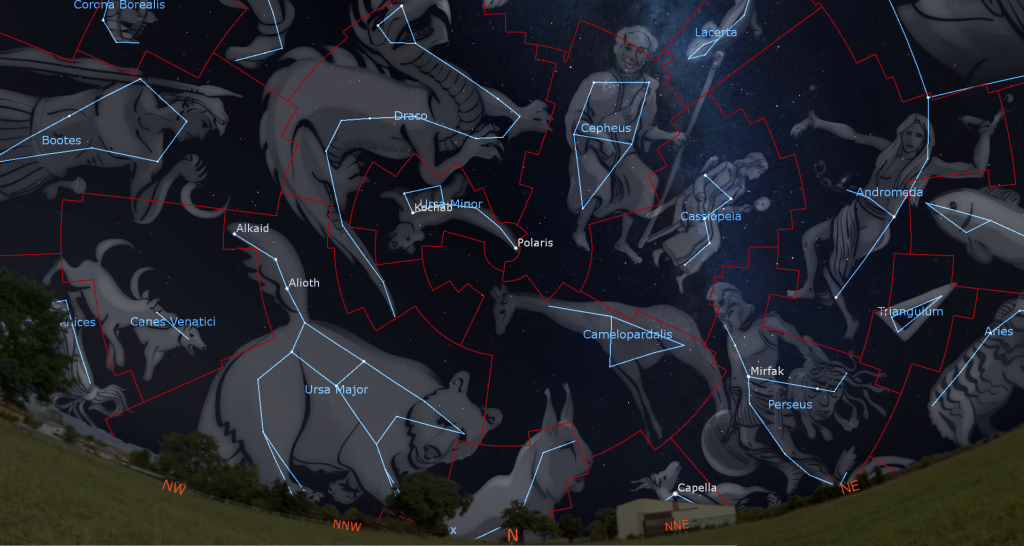
In form, Cepheus is little more than a triangle affixed to one edge of a square – like a crooked house with a tall pointed roof. From classical star atlases, the peak of the roof marks the king’s feet, and the stars forming the base of the house mark his head and shoulders. Because he circles the pole, you might see him right-way up, upside-down, or sideways – depending on the time of year and time of night. This month, he’ll be head-up and feet-down during evening – but the “house shape” will be oriented so the roof points down.
The brighter stars of Cepheus span 21° (about two fist widths) of sky, from his toes to his crown, by 9°, the width of his hips and shoulders – but the constellation’s territory covers double both of those dimensions. It extends from Polaris southward between Cassiopeia and Draco (the Dragon) and to the borders of Cygnus (the Swan) and Lacerta (the Lizard). Viewed while facing north, the bright, W-shaped constellation of his wife Cassiopeia sits to the king’s right (celestial west), and the curved neck of the dragon is on his left (east). Bright Deneb sits high over his left shoulder, and the lizard is creeping downwards towards his right shoulder – although he seems to fending it off with an upraised staff. Some star maps connect a pair of stars to his left shoulder – as if his arm is extended.

Cepheus’ brightest star is magnitude 2.45 Alderamin, from the Arabic expression for “the Right Arm”. (Since he’s facing you, his right is on your left.) Bright enough to see even in light-polluted skies, Alderamin is a white, A-class star located about 49 light-years from our solar system. It’s somewhat hotter than our sun and about twice the size. It also appears to have a very high rotation rate of 12 hours, versus our own sun’s sedate 27 days!
Eta Cephei (or Kebalfird or η Cep), the medium-bright star sitting about four finger widths to the left of Alderamin, marks the king’s elbow. A dimmer star designated Theta Cephei (or θ Cep) sits two finger widths to the lower left of Eta. It marks the king’s right hand.
Starting back at Alderamin, look a bit less than a fist’s diameter below, and slightly to the right of it, for a moderately bright star named Alfirk (“the Flock”) or Beta Cephei (or β Cep). Alfirk, which marks the king’s hip, is a pulsating variable star located 690 light-years away from us! This hot, blue-white star is more than ten times the mass of our sun, and has at least two companion stars that are too close to it to see visually. The star varies slightly in brightness every 4 hours and 34 minutes, due to the effects of iron enrichment in the star’s interior.
Errai (“the Shepherd”), also designated Gamma Cephei (or γ Cep), sits a generous fist diameter to the lower right of Alfirk – at the “peak of the house’s roof”. It’s an orange, K-class star that shines as brightly as Alfirk – although it is only 44 light-years away from us. This star, which marks the king’s feet, is a binary star system that includes a faint, red dwarf star. In 1988 Canadian astronomers detected the signal of an extra-solar planet around Errai. It would have been the first one confirmed – but their data wasn’t definitive enough. That honour went to the star 51 Pegasi a few years later. Newer, better data confirmed Errai’s planet in 2002, now named Tadmor – the ancient Semitic name for the city of Palmyra in Syria.
The star Iota Cephei (or i Cep) completes the triangle of lower Cepheus. That orange-tinted, K-class star shines about as brightly as Errai below it and Alfirk to its left. A fist’s diameter above Iota, and a generous palm’s width to the upper right of Alderamin, is Zeta Cephei (or ζ Cep). It’s another orange giant star that shines at magnitude 3.35, about the same brightness as the other corner stars.
A little star named Epsilon Cephei (or ε Cep) sits just a finger’s width above Zeta. It shines at a modest magnitude 4.2, about half as bright as Zeta. But the really interesting star is the one located about two finger widths to Zeta’s lower right. That’s Delta Cephei (or δ Cep). Delta Cephei varies in brightness by more than a factor of two every 5 days and 9 hours. At its peak, it’s as bright as Zeta. At its minimum, it’s as bright as Epsilon. So you can tell at a glance which part of its cycle it’s in! Delta is also a nice double star when viewed in telescopes – splitting into a brighter yellow star and a dimmer blue star.

Delta Cephei is a giant, pulsating supergiant star located about 900 light-years from our sun. Its variability occurs because it has consumed its core hydrogen, and it is entering old age. There are many of these stars in the sky – including Polaris! They are now known as Cepheid variable stars. In 1912, Henrietta Swan Leavitt of Harvard discovered that the time they take to cycle in brightness (their period) relates directly to their maximum brightness. Knowing that, she and other astronomers have been able to use them as “Standard Candles” to measure distances in the Universe, as follows: Find a Cepheid-type variable, measure its period, calculate its expected maximum brightness, and compare how bright it is with how bright it looks. (It’s similar to estimating how far away a motorcycle is at night by how bright its headlight appears.) Cepheid variables have been used to estimate the size of our Milky Way, and to work out the distances of other galaxies, like the Andromeda Galaxy.
Our last stop in the tour of Cepheus’ stars is Mu Cephei (or μ Cep), also known as Herschel’s Garnet Star. It’s one of my favorite objects. It’s located midway between Alderamin and Zeta Cephei, and just above the line connecting those two stars. You can see it with unaided eyes in a dark sky. And that’s amazing because this star is a whopping 2400 light-years away from us! (Actually, we’re not that sure about the distance – it could be farther.)
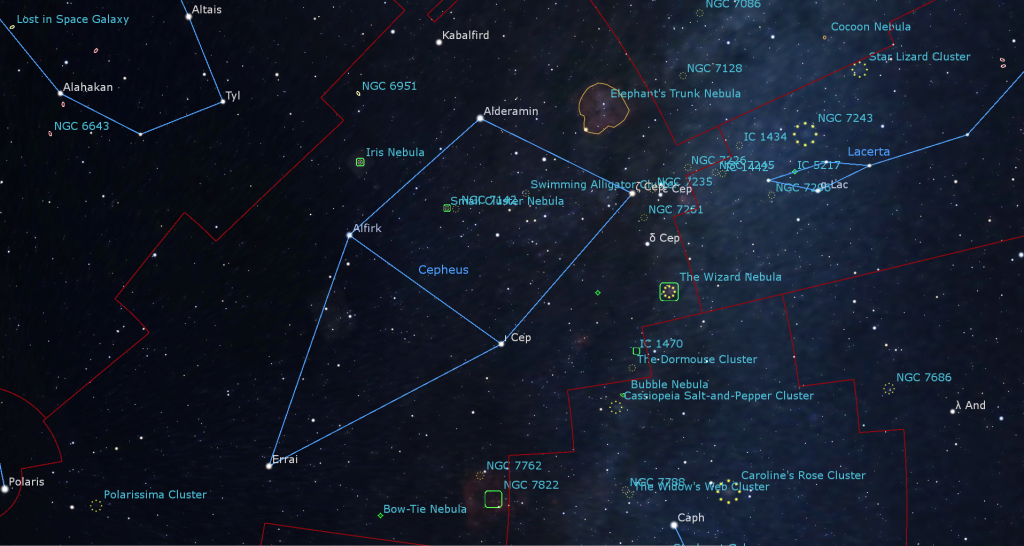
Mu Cephei is visible at such a distance because it is huge – about 1400 times the size of our sun. If it traded places with our star, the orbits of all the planets out to Jupiter would be inside the star! What makes it truly amazing to look at is the colour. It’s among the reddest bright stars in the sky. It’s an M-class star nearing the end of its life – similar to the much closer-to-Earth Betelgeuse in Orion (the Hunter). One day it will explode in a supernova.
I’ll devote a future story to the deep sky objects in Cepheus – but you will certainly see rich star fields, star clusters, and nebulas if you sweep the constellation with binoculars or a backyard telescope. For example, Mu Cephei is on the northern edge of a great cloud of pink hydrogen gas known as the Elephant’s Trunk Nebula. It’s four times the width of the full moon, and it will extend upward from Mu Cephei during September evenings. Other smaller nebulas include the Wizard Nebula (NGC 7380) near Delta Cephei, and the Iris Nebula (NGC 7023) near Alfirk.
There is an open star cluster between Zeta and Delta named NGC 7261, another two finger widths to the upper left of Eta Cephei named NGC 6939, and one more in the centre of the large square, near the king’s heart called the Swimming Alligator Cluster (or NGC 7160). Way down near Polaris is the Polarissima Star Cluster (NGC 188). That dense cluster of small stars is half the width of the full moon, and is object number 1 in the Caldwell list.
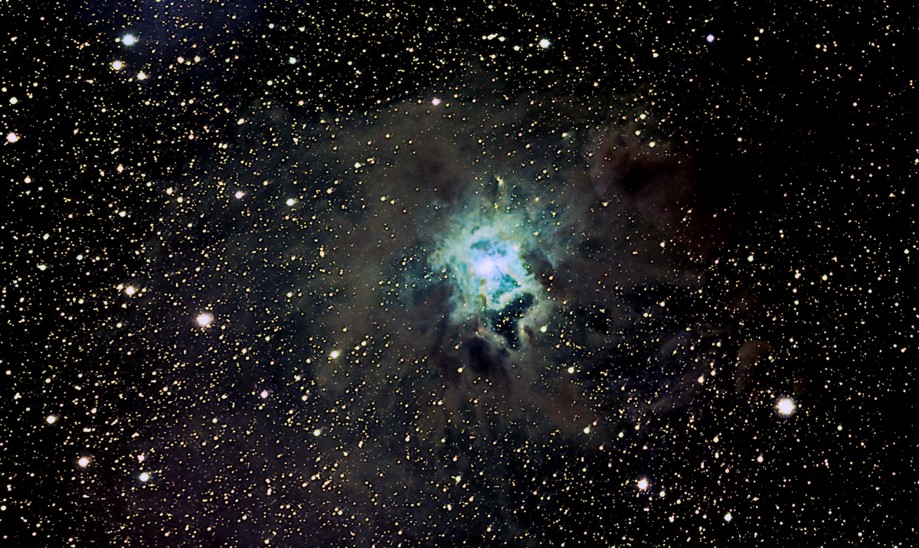
As a final thought – Cepheus is truly the king of the North Pole. Errai will replace Polaris as Earth’s pole star around 4000 AD. Alfirk will take that honour around 6500 AD. And then Alderamin will take over in 7500 AD! Let me know how your audience with the king goes!
Public Astronomy-Themed Events
Every Monday evening, York University’s Allan I. Carswell Observatory runs an online star party – broadcasting views from four telescopes/cameras, answering viewer questions, and taking requests! Details are here. They host in-person viewing on the first clear Wednesday night each month. Other Wednesdays they stream views online via the observatory YouTube channel. Details are here.
On Wednesday evening, September 6 at 7:30 pm EDT, the RASC Toronto Centre will host their free, public, in-person monthly Recreational Astronomy Night Meeting in the Gemini East Room at the Ontario Science Centre. The meeting will also be live streamed at https://www.youtube.com/rasctoronto/live. Talks include The Sky This Month, A report on a trip to see a recent solar eclipse, and a talk by Dan Falk on Edmund Halley. Details are here.
After more than three years and 75 shows, I’ve retired my Insider’s Guide to the Galaxy YouTube livestreams with the Royal Astronomical Society of Canada. In March, 2020, I pitched the project to entertain and educate young and old astronomy and space enthusiasts who were locked down for the pandemic. Now that we’re all back to work, I no longer have the time needed to research and present the material. We hosted a wide variety of special guests, went on location, and covered almost everything under the sun, literally. The playlist will remain available on Youtube at https://www.youtube.com/playlist?list=PLzou3EKq3thtMneFq2JD2SvfzhJkDVlxY. Let me know if you see something that inspires you.
Keep your eyes on the skies! I love getting questions and requests. Send me some!